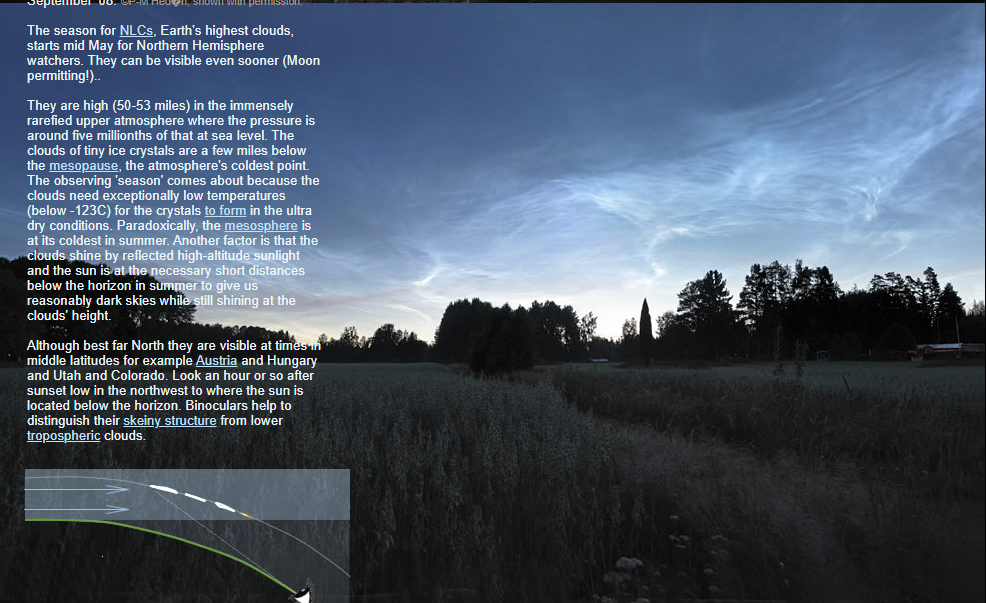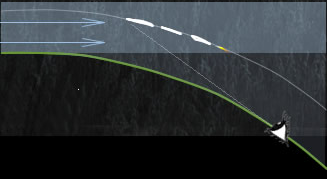NLC season nigh
NLC Season Nigh: Witness the Spectacular Noctilucent Clouds
As mid-May approaches, Northern Hemisphere watchers eagerly anticipate the start of the season for Noctilucent Clouds (NLCs), Earth's highest clouds. These ethereal formations, composed of tiny ice crystals, can be seen even earlier under the right conditions. Let's delve into the fascinating world of NLCs and discover what makes them so captivating.
A Glimpse into the Upper Atmosphere
Noctilucent clouds reside at an astonishing altitude of 50-53 miles, in the immensely rarefied upper atmosphere. To put it into perspective, the atmospheric pressure at this height is roughly five millionths of that at sea level. The clouds hover a few miles below the mesopause, which marks the coldest point in the Earth's atmosphere. The peculiar observing "season" for NLCs occurs due to the need for exceptionally low temperatures, dipping below -123°C, and the ultra-dry conditions necessary for ice crystal formation. Surprisingly, the mesosphere, where NLCs thrive, reaches its lowest temperatures during the summer months.
The Enigmatic Glow of Noctilucent Clouds
One of the mesmerizing aspects of NLCs is their radiant glow. These clouds emit a shimmering light due to the reflection of high-altitude sunlight. However, to observe this phenomenon, specific conditions must align. During summer, the sun hovers at just the right distance below the horizon, allowing us to enjoy reasonably dark skies while still illuminating the clouds at their elevated height. It is this interplay between sunlight and the position of the observer that grants us the opportunity to witness the captivating display of NLCs.
Global Visibility
While NLCs are most commonly observed in far Northern regions, they occasionally grace middle latitudes with their presence. Enthusiasts in Austria, Hungary, Utah, and Colorado have reported sightings of these celestial wonders. To spot NLCs, one should look towards the northwest approximately an hour after sunset, where the sun lies just below the horizon. Binoculars can be useful in distinguishing the intricate structure of NLCs from lower tropospheric clouds.
The Science Behind Noctilucent Clouds
NLCs owe their existence to a complex interplay of various atmospheric factors. Here are some key points to help unravel the mystery behind these mesmerizing formations:
- NLCs form in the mesosphere, an atmospheric layer between 30 and 53 miles above the Earth's surface.
- The mesosphere experiences extremely low temperatures, which plummet to below -123°C during summer.
- These icy clouds consist of tiny water droplets and ice crystals, typically measuring around 0.0001 millimeters in diameter.
- The unique conditions required for NLC formation include the presence of water vapor, dust particles for ice nuclei, and temperatures low enough to freeze the moisture into ice crystals.
- NLCs exhibit a delicate, fibrous structure due to the way the ice crystals align and interact with each other.
A Sight to Behold
Witnessing the enchanting display of Noctilucent Clouds is a truly awe-inspiring experience. As the NLC season approaches, make sure to keep an eye on the evening sky. Here are some tips to enhance your chances of catching a glimpse:
- Find a location with minimal light pollution, preferably away from cities or bright sources of artificial light.
- Choose a clear night with a favorable weather forecast, as cloud cover can obstruct visibility.
- Bring binoculars or a camera with a telephoto lens to enhance your view and capture the intricate details of the NLCs.
- Be patient and allow your eyes to adjust to the darkness, as NLCs may appear faint at first but gradually become more visible.
Conclusion
Noctilucent Clouds are a celestial marvel that grace our skies during the summer months. Their ethereal glow and delicate structure captivate the hearts of skywatchers around the world. Understanding the science behind these high-altitude clouds adds an extra layer of intrigue to their beauty. So, mark your calendars and prepare to embark on a celestial journey as the NLC season approaches.

Noctilucent Clouds, Sweden, A display captured by P-M Hed�n (photography site, more NLCs) September '08. ©P-M Hed�n, shown with permission.
The season for NLCs, Earth's highest clouds, starts mid May for Northern Hemisphere watchers. They can be visible even sooner (Moon permitting!)..
They are high (50-53 miles) in the immensely rarefied upper atmosphere where the pressure is around five millionths of that at sea level. The clouds of tiny ice crystals are a few miles below the mesopause, the atmosphere's coldest point. The observing 'season' comes about because the clouds need exceptionally low temperatures (below -123C) for the crystals to form in the ultra dry conditions. Paradoxically, the mesosphere is at its coldest in summer. Another factor is that the clouds shine by reflected high-altitude sunlight and the sun is at the necessary short distances below the horizon in summer to give us reasonably dark skies while still shining at the clouds' height.
Although best far North they are visible at times in middle latitudes for example Austria and Hungary and Utah and Colorado. Look an hour or so after sunset low in the northwest to where the sun is located below the horizon. Binoculars help to distinguish their skeiny structure from lower tropospheric clouds.


Note: this article has been automatically converted from the old site and may not appear as intended. You can find the original article here.
Reference Atmospheric Optics
If you use any of the definitions, information, or data presented on Atmospheric Optics, please copy the link or reference below to properly credit us as the reference source. Thank you!
-
<a href="https://atoptics.co.uk/blog/nlc-season-nigh/">NLC season nigh</a>
-
"NLC season nigh". Atmospheric Optics. Accessed on November 26, 2024. https://atoptics.co.uk/blog/nlc-season-nigh/.
-
"NLC season nigh". Atmospheric Optics, https://atoptics.co.uk/blog/nlc-season-nigh/. Accessed 26 November, 2024
-
NLC season nigh. Atmospheric Optics. Retrieved from https://atoptics.co.uk/blog/nlc-season-nigh/.